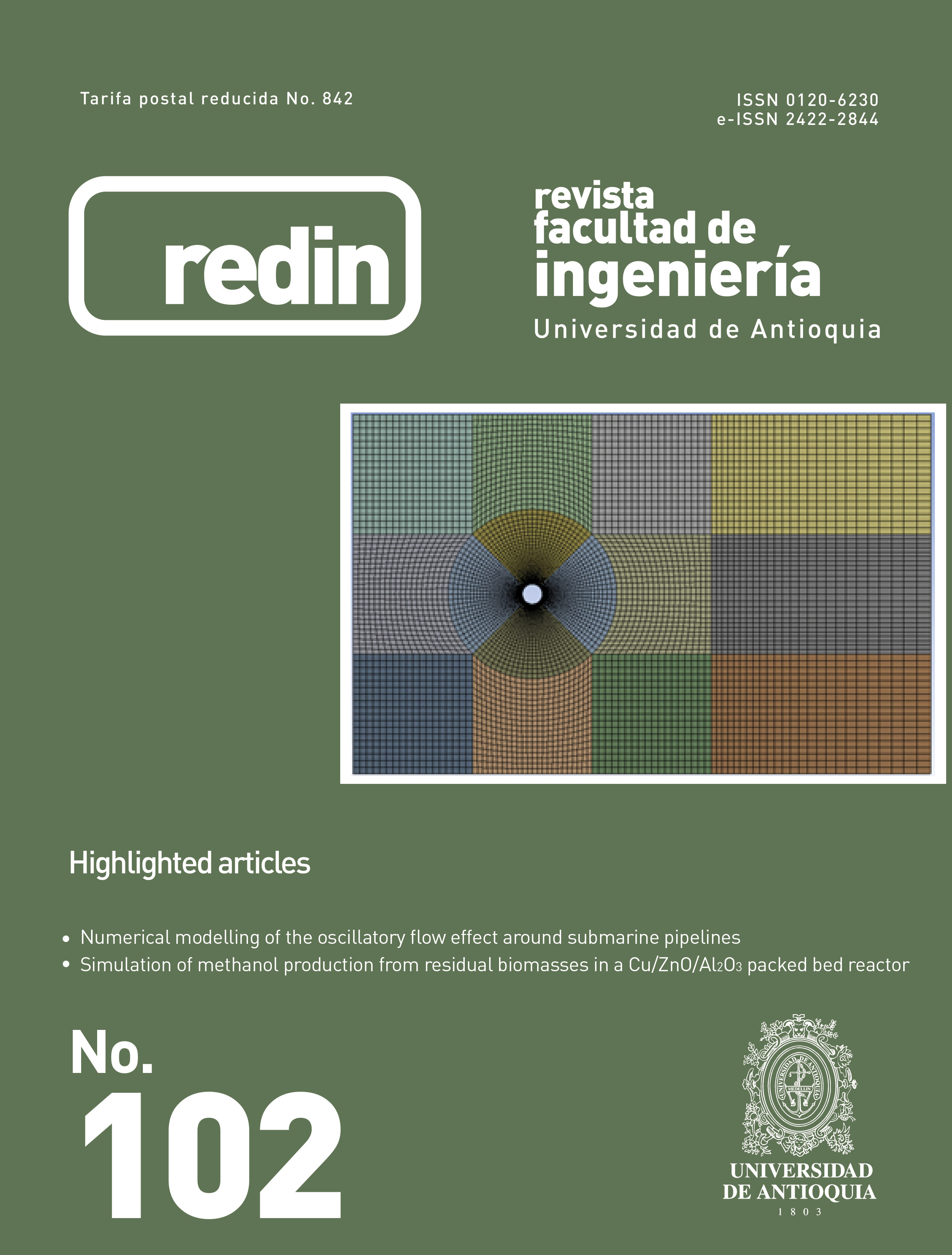Método de monitoreo y detección de fallos en el sistema fotovoltaico basado en aprendizaje automático
DOI:
https://doi.org/10.17533/udea.redin.20200694Palabras clave:
inteligencia artificial, fuentes de energía renovable, supervisiónResumen
Los métodos de aprendizaje automático se han utilizado para resolver problemas prácticos complicados en diferentes áreas y se están volviendo cada vez más populares hoy en día. El propósito de este artículo es evaluar la predecición de la producción de energía de tres sistemas fotovoltaicos diferentes y la supervision de sensores de medición, por medio un aprendizaje automático y minería de datos en respuesta al comportamiento de las variables climáticas del lugar en estudio. Por otro lado, también incluye la implementación de los modelos resultantes en el sistema SCADA por medio de indicadores, que permitirá al operador gestionar activamente la red eléctrica. Ademas ofrece una estrategia en la simulación y predicción en tiempo real de sistemas fotovoltaicos y sensores de medición en el concepto de redes inteligentes.
Descargas
Citas
C. Voyant and et al, “Machine learning methods for solar radiation forecasting: A review,” Renewable Energy, vol. 105, May 2017. [Online]. Available: https://doi.org/10.1016/j.renene.2016.12.095
S. Theocharides, G. Makrides, G. E. Georghiou, and A. Kyprianou, “Machine learning algorithms for photovoltaic system power output prediction,” in 2018 IEEE International Energy Conference (ENERGYCON), Limassol, Cyprus, 2018.
C. Kurien and A. K. Srivastava, “Scope of artificial intelligence techniques for exhaust emission prediction of CI engines and renewable energy applications„” International Journal of Engineering Research in Computer Science and Engineering, vol. 5, no. 2, pp. 456–461, Feb 2018.
S. Preda, S. Vasilica, A. Bâra, and A. Belciu, “PV forecasting using support vector machine learning in a big data analytics context,”Symmetry, vol. 10, no. 12, December 2018. [Online]. Available: https://doi.org/10.3390/sym10120748
T. T. Teo, T. Logenthiran, W. L. Woo, and K. Abidi, “Forecasting of photovoltaic power using regularized ensemble extreme learning machine,” in 2016 IEEE Region 10 Conference (TENCON), Singapore, Singapore, 2017, pp. 455–458.
T. Huuhtanen and A. Jung, “Predictive maintenance of photovoltaic panels via deep learning,” in 2018 IEEE Data Science Workshop (DSW), Lausanne, Switzerland, 2018.
H. T. Pedro, C. F. Coimbra, M. David, and P. Lauret, “Assessment of machine learning techniques for deterministic and probabilistic intra-hour solar forecasts,” Symmetry, vol. 123, August 2018. [Online]. Available: https://doi.org/10.1016/j.renene.2018.02.006
M. N. Akhter, S. Mekhilef, H. Mokhlis, and N. M. Shah, “Review on forecasting of photovoltaic power generation based on machine learning and metaheuristic techniques,” IET Renewable Power Generation, vol. 13, no. 7, May 9 2019. [Online]. Available: https://doi.org/10.1049/iet-rpg.2018.5649
C. Tu, X. He, Z. Shuai, and F. Jiang, “Big data issues in smart grid – A review,” Renewable and Sustainable Energy Reviews, vol. 79, November 2017. [Online]. Available: https://doi.org/10.1016/j.rser.2017.05.134
S. Siniscalchi and F. D. Bianchi and M. De Prada and C. Ocampo, “A wind farm control strategy for power reserve maximization,”Renew. Energy, vol. 131, February 2019. [Online]. Available: https://doi.org/10.1016/j.renene.2018.06.112
F. Han and et al, “An intelligent fault diagnosis method for pv arrays based on an improved rotation forest algorithm,”Energy Procedia, vol. 158, February 2019. [Online]. Available: https://doi.org/10.1016/j.egypro.2019.01.498
E. Garoudja, A. Chouder, K. Kara, and S. Silvestre, “An enhanced machine learning based approach for failures detection and diagnosis of PVsystems,” Energy Procedia, vol. 158, February 2019. [Online]. Available: https://doi.org/10.1016/j.egypro.2019.01.498
D. Benavides, P. Arévalo, L. G. Gonzalez, L. Hernández, and F. Jurado, “Machine learning data applied to monitoring PV systems: A case study*,” in Ibero-American Congress of Smart Cities (ICSC-CITIES 2019), Soria, Spain, 2019, pp. 456–470.
S. K. Jha, J. Bilalovic, A. Jha, N. Patel, and H. Zhang, “Renewable energy: Present research and future scope of Artificial Intelligence,”Renewable and Sustainable Energy Reviews, vol. 77, September 2017. [Online]. Available: https://doi.org/10.1016/j.rser.2017.04.018
J. Li, J. K. Ward, J. Tong, L. Collins, and G. Platt, “Machine learning for solar irradiance forecasting of photovoltaic system,”Renew. Energy, vol. 90, May 2016. [Online]. Available: https://doi.org/10.1016/j.renene.2015.12.069
M. K. Behera, I. Majumder, and N. Nayak, “Solar photovoltaic power forecasting using optimized modified extreme learning machine technique,” Eng. Sci. Technol. an Int. J., vol. 21, no. 3, June 2018. [Online]. Available: https://doi.org/10.1016/j.jestch.2018.04.013
J. L. Espinoza, L. G. González, and R. Sempértegui, “Micro grid laboratory as a tool for research on non-conventional energy sources in Ecuador,” in 2017 IEEE International Autumn Meeting on Power, Electronics and Computing (ROPEC), Ixtapa, Mexico, 2018.
D. J. Benavides, F. Jurado, and L. G. González, “Data analysis and tools applied to modeling and simulation of a PV system in Ecuador,” Enfoque UTE, vol. 9, no. 4, 2018. [Online]. Available: https://doi.org/10.29019/enfoqueute.v9n4.389
MathWorks. Machine Learning with MATLAB. The MathWorks, Inc. Accessed Nov. 6, 2019. [Online]. Available: https://bit.ly/3hXzJzs
Descargas
Publicado
Cómo citar
Número
Sección
Licencia
Derechos de autor 2020 Revista Facultad de Ingeniería Universidad de Antioquia

Esta obra está bajo una licencia internacional Creative Commons Atribución-NoComercial-CompartirIgual 4.0.
Los artículos disponibles en la Revista Facultad de Ingeniería, Universidad de Antioquia están bajo la licencia Creative Commons Attribution BY-NC-SA 4.0.
Eres libre de:
Compartir — copiar y redistribuir el material en cualquier medio o formato
Adaptar : remezclar, transformar y construir sobre el material.
Bajo los siguientes términos:
Reconocimiento : debe otorgar el crédito correspondiente , proporcionar un enlace a la licencia e indicar si se realizaron cambios . Puede hacerlo de cualquier manera razonable, pero no de ninguna manera que sugiera que el licenciante lo respalda a usted o su uso.
No comercial : no puede utilizar el material con fines comerciales .
Compartir igual : si remezcla, transforma o construye a partir del material, debe distribuir sus contribuciones bajo la misma licencia que el original.
El material publicado por la revista puede ser distribuido, copiado y exhibido por terceros si se dan los respectivos créditos a la revista, sin ningún costo. No se puede obtener ningún beneficio comercial y las obras derivadas tienen que estar bajo los mismos términos de licencia que el trabajo original.










 Twitter
Twitter